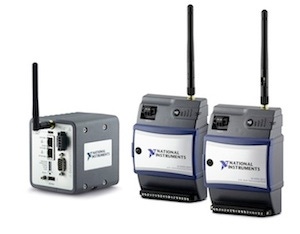March 31, 2011

Two newproducts are extending the capabilities of the NationalInstruments wireless sensor network (WSN) platform. A new 9792 programmablegateway provides a platform for embedded wireless monitoring and data loggingthat doesn't require a connection to a back end system. The WSN-3226voltage/resistance temperature detector (RTD) combination node extends themeasurement capabilities to include support for resistance-based measurementssuch as RTDs and potentiometers.
Embedded Wireless Monitoring_A |
"Theidea behind releasing the NI 9792 gateway is targeting more embedded wirelessmonitoring applications," says Nick Butler, wireless sensor network product managerfor National Instruments. "What we mean by embedded is headless applicationswhere we don't need a host controller in the system. Similar to systems createdwith CompactRIO and other LabVIEW real-time targets, the gateway doesn't needto be tethered to a back end system."
"Thegateway can be deployed to monitor a bridge, tunnel, mine shaft, winery or rainforest without the need for an Ethernet connection back to a Windows PC, PXIsystem or any other controller," Butler says. "Users can have data loggingapplications, analysis, trending and alarming all running locally on thegateway."
Thegateway is programmable using the LabVIEW Real-Time Module for stand-aloneoperation and features a high-performance 533 MHz processor and 2 GByte ofonboard storage for embedded data-logging. It features integrated web (HTTP)and file (FTP) servers which makes it possible for remote access to measurementdata from thin client devices such as smartphones and mobile computers. AnRS232 serial port and dual Ethernet ports provide flexible connectivity toother devices such as enterprise-level networks or wired I/O systems.
Animportant feature is the new built-in web server. With any type of monitoringapplication, there is always the question of data visualization. If the gatewayis in a remote location, how will the user get data if it isn't tethered toanything? The value of the local I/O is the ability to add a radio modem to thesystem next to the gateway. Typically cell modems and other devices willcommunicate via Ethernet, TCP/IP, Modbus or serial, all open standards that theuser can program in the LabVIEW real-time application running on the gateway.Without investing in a separate controller, the system can provide monitoring,processing and visualization of the data. Users can also combine the gatewaywith a CompactRIO controller to easily implement a wired and wirelessmeasurement system, because the APIs are very similar.
Monitoringapplications are typically split between those that require high speed, highthroughput and maybe FPGA timing synchronization and processing on the wiredside with slower speed, more SCADA-type systems that NI is addressing throughthe WSN platform.
"We seea trend moving toward wireless in all facets except for high speed control,"says Butler. "A high percentage of customers intend to adopt wirelesstechnology in the future and the majority is planning to adopt wireless formeasurements."
Butlersays the real controversy today is whether wireless is suited for control. Withthe latency of over-the-air communications and the potential for nodes ordistributed wireless devices to lose their wireless connection or experienceinterference, the jury is still very much out on wireless for control formission-critical applications. "But in measurement applications, we havealready crossed that chasm and we're seeing heavy adoption of wirelessmeasurement technology today," says Butler.
Alongwith the new gateways, three measurement nodes include a +10V analoginput node and a 24-bit thermocouple node. The WSN-3226 measurement node addsresistance-based measurements to the WSN platform and features four analoginput channels that can be configured on a per-channel basis for plus or minus 10Vmeasurements or resistive measurements.
TheWSN-3226 features two bidirectional digital channels that can be configured ona per-channel basis for input, sinking output or sourcing output. Additionally,the measurement node can be powered by four AA batteries, with an operationallifetime of up to three years, or externally powered with a 5 to 30V supply,which offers improved efficiency for energy harvesting applications.
Butlersays the main application they are targeting is adding RTDs to the WSNplatform. Typically customers that require high accuracy temperaturemeasurements select an RTD rather than a thermocouple for their temperaturemonitoring applications. With the release of this node, WSN devices cannatively interact with RTDs for temperature measurements and combine those withanalog input measurements on the same node.
"All ofthe nodes are available in a programmable version, and allow users to takeadvantage of LabVIEW graphical programming to wirelessly deploy analysis andcontrol programs that run autonomously on the WSN measurement nodes," saysButler. "The deployed applications can control the digital lines for ON/OFFcontrol, save data samples locally to Flash memory, and perform local analysis,averaging or data reduction."
In awater treatment facility, for example, a customer could take pH and dissolvedoxygen measurements in the tanks once an hour, store the 24 samples to Flashmemory, then average them or send all 24 data points at midnight each day. Thisflexibility provides users with the ability to customize the operation ofmeasurement nodes to optimize power consumption and performance.
"Onekey differentiator of wireless sensor network devices is that the user can programhow the node operates, how often it samples, what it does with the data, howoften it transmits that data and how often it responds to digital value changeson the DIO lines." says Butler. "You can even respond to network statuschanges. For example, if your gateway happens to lose power, the node'sdeployed application will continue to run and you can start saving data locallyto the node. Upon reconnection to the gateway, the node can automaticallytransmit all of the sampled data so that none is lost even if the network goesdown momentarily."
About the Author(s)
You May Also Like







